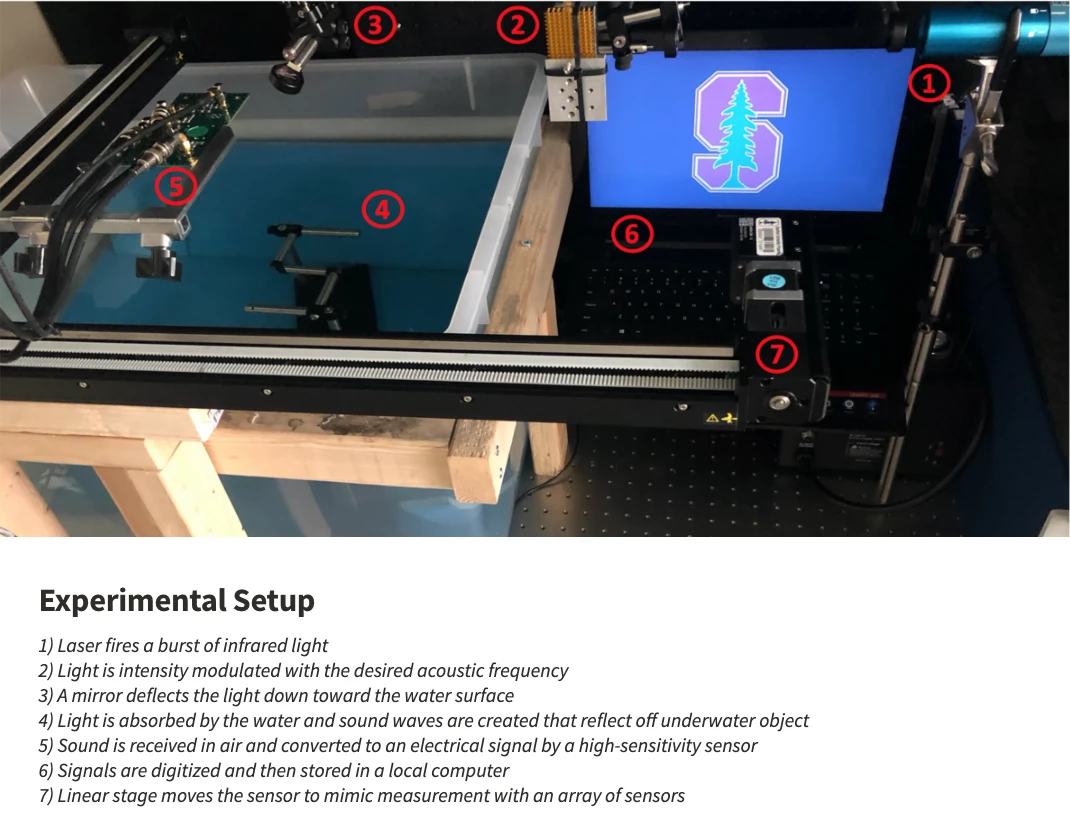Radar and LiDAR have been incredibly quick and effective tools for mapping and surveying the Earth's surface from aircraft and satellites, but while they can deliver accurate readings through cloud and even forest canopy cover, they can't tell you what's below the surface of the sea. Seawater absorbs far too much of the signal.
Sonar remains the most effective way to map out the sea floor – but the vast majority of the oceans that form 70 percent of the Earth's surface remain unmapped, because sonic waves have hitherto only been able to be sent out from underwater. Sound waves sent from air into water lose more than 99.9 percent of their energy in the translation; it's why the outside world goes so wonderfully silent when you dive down to the bottom of the pool. The meagre remaining 0.1 percent of the energy does create a sonar signal, but that loses a further 99.9 percent of its energy upon coming back up from the water into the air.
Sonar is commonly used for submarine detection, among other things, by military forces the world over, chiefly using devices on the undersides of ships. But the closest things thus far to an airborne sonar system are "dippers" like Thales' FLASH system; low-frequency, wide-band sonar systems that dangle from cables out the bottom of helicopters and dip into the sea below like noisy teabags. These methods are slow, expensive, and no good at covering large areas.
Now, a Stanford team believes it's figured out how to send and receive sonar signals from airborne platforms without touching the water, in a development that could eventually make it much easier to map the sea floor and survey marine life.
While sound waves and electromagnetic radiation alike reach a dead end at the air-to-water surface barrier, the team has found that a photoacoustic approach can at least get the signal through the barrier in one direction.

The Photoacoustic Airborne Sonar System, or PASS, fires a laser into the surface of the water, its intensity pulsed to the desired acoustic frequency, and as this laser energy is absorbed, it creates ultrasonic waves in the water that can act as effective sonar waves, bouncing off underwater objects before returning up to the surface.
“If we can use light in the air, where light travels well, and sound in the water, where sound travels well, we can get the best of both worlds,” said graduate student Aidan Fitzpatrick, first author on a study released through IEEE Access.
Moving back from the water into the air does sap these sound waves of nearly all their energy, but this one-way loss still leaves enough signal to be "heard" by transducers on the airborne device. “We have developed a system that is sensitive enough to compensate for a loss of this magnitude and still allow for signal detection and imaging,” said study leader Amin Arbabian.
Once the signal has been recorded, it's analyzed by software to create a 3D image of the submerged object. The software is able to correct for refraction of the sound waves as they come out of the water and into the air.

At this point, the team has tested a prototype of the PASS device at small scale, holding it steady over a plastic storage tub full of still water to produce a 3D image of a metal S submerged below the surface.
Clearly, there are big challenges ahead if this technology is to prove useful in mapping the sea floor. For starters – and the team is working toward this – open water does not stay still. Waves and ripples constantly change the shape and height of the surface, and this will affect the signal in several different ways that need to be accounted for. "We are currently working toward dealing with water waves,” Fitzpatrick said. “This is a challenging but we think feasible problem.”
Then there's the problem of the deployment vehicle itself. “Our vision for this technology is on-board a helicopter or drone,” said Fitzpatrick. “We expect the system to be able to fly at tens of meters above the water.” Both helicopters and drones push a lot of air and make a lot of noise, and this – not to mention the noise of the environment itself – could pose further challenges to the super-sensitive transducers as they try to pick out the tiny remaining fragments of sound waves that make it back up out of the water.

Then there's the matter of whether it scales, and how powerful this system would have to be in order to generate a sonar system that's capable of mapping the floor of the deep ocean from a drone flying above the surface.
Still, the research thus far has been supported by the US Office of Naval Research and the Advanced Research Projects agency-Energy (ARPA-E), so presumably resources won't be holding this team back as it pushes forward. Check out a short video below.
The study was published in IEEE Access.
Source: Stanford University





